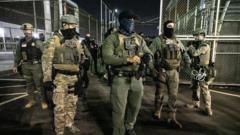**A heated exchange between Musk and cabinet members prompted President Trump to reinforce his administration's priorities while still supporting Musk's cost-cutting efforts.**
**Trump Shifts Dynamics with Musk Following Tense Cabinet Meeting**

**Trump Shifts Dynamics with Musk Following Tense Cabinet Meeting**
**In a recent cabinet meeting, President Trump reaffirmed authority to cabinet secretaries, limiting Elon Musk's influence amid spending cut initiatives.**
In a dramatic turn of events during a cabinet meeting held Thursday, President Donald Trump appeared to be reining in Elon Musk’s influence in the administration’s cost-cutting strategies. The meeting turned contentious, with Musk reportedly clashing with Secretary of State Marco Rubio and Transportation Secretary Sean Duffy over the efficiency and staffing levels of their respective departments. According to reports from the New York Times, Musk confronted Rubio about perceived shortcomings in his efforts to reduce staff numbers, stating he was “good on TV” but lacking effectiveness in his diplomatic role.
The situation escalated as Musk and Duffy debated the implications of Musk's Department of Government Efficiency (Doge) task force, particularly regarding layoffs of air traffic controllers at a time when the Federal Aviation Administration is already grappling with staffing shortages. Trump, after listening to the exchanges, stepped in to emphasize his continued support for Doge but clarified that cabinet secretaries would maintain primary control over their departments moving forward, with Musk's team relegated to an advisory role.
Following the meeting, Trump took to social media to discuss his directives to the cabinet, urging them to collaborate with Doge on “cost-cutting measures” while suggesting a careful approach akin to using a “scalpel” instead of a “hatchet” to manage personnel changes.
This latest cabinet meeting marked a notable shift in the dynamics of Trump's collaboration with the prominent tech entrepreneur, as the administration's initial, seemingly unified stance on slashing government expenses faced its first real contention. Musk’s aggressive tactics toward reducing government expenditures, which included controversial attempts to encourage federal workers to accept early resignation packages, had raised eyebrows and prompted varying responses from different agencies.
Despite the tensions, Trump later characterized the meeting as an uninhibited exchange of ideas among his cabinet, downplaying reports of discord. He reaffirmed both Rubio's and Musk's abilities to work together effectively. While many anticipate the potential for future clashes given Musk's influential position, the president seems determined to maintain a balance of control.
As evidenced by Musk's recent participation aboard Air Force One for a weekend trip to Mar-a-Lago, the partnership between Trump and Musk, the wealthiest man globally, appears to be as formidable as ever. Nevertheless, the cabinet room incident serves as a reminder of the complexity of their relationship and the challenges inherent in merging the political and business worlds. As the Trump administration continues to navigate this evolving dynamic, the question of Musk's role and the extent of his authority remains at the forefront of political discourse.
The situation escalated as Musk and Duffy debated the implications of Musk's Department of Government Efficiency (Doge) task force, particularly regarding layoffs of air traffic controllers at a time when the Federal Aviation Administration is already grappling with staffing shortages. Trump, after listening to the exchanges, stepped in to emphasize his continued support for Doge but clarified that cabinet secretaries would maintain primary control over their departments moving forward, with Musk's team relegated to an advisory role.
Following the meeting, Trump took to social media to discuss his directives to the cabinet, urging them to collaborate with Doge on “cost-cutting measures” while suggesting a careful approach akin to using a “scalpel” instead of a “hatchet” to manage personnel changes.
This latest cabinet meeting marked a notable shift in the dynamics of Trump's collaboration with the prominent tech entrepreneur, as the administration's initial, seemingly unified stance on slashing government expenses faced its first real contention. Musk’s aggressive tactics toward reducing government expenditures, which included controversial attempts to encourage federal workers to accept early resignation packages, had raised eyebrows and prompted varying responses from different agencies.
Despite the tensions, Trump later characterized the meeting as an uninhibited exchange of ideas among his cabinet, downplaying reports of discord. He reaffirmed both Rubio's and Musk's abilities to work together effectively. While many anticipate the potential for future clashes given Musk's influential position, the president seems determined to maintain a balance of control.
As evidenced by Musk's recent participation aboard Air Force One for a weekend trip to Mar-a-Lago, the partnership between Trump and Musk, the wealthiest man globally, appears to be as formidable as ever. Nevertheless, the cabinet room incident serves as a reminder of the complexity of their relationship and the challenges inherent in merging the political and business worlds. As the Trump administration continues to navigate this evolving dynamic, the question of Musk's role and the extent of his authority remains at the forefront of political discourse.





















